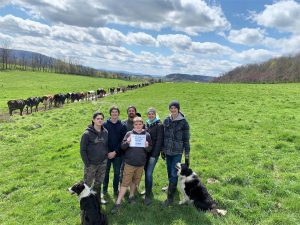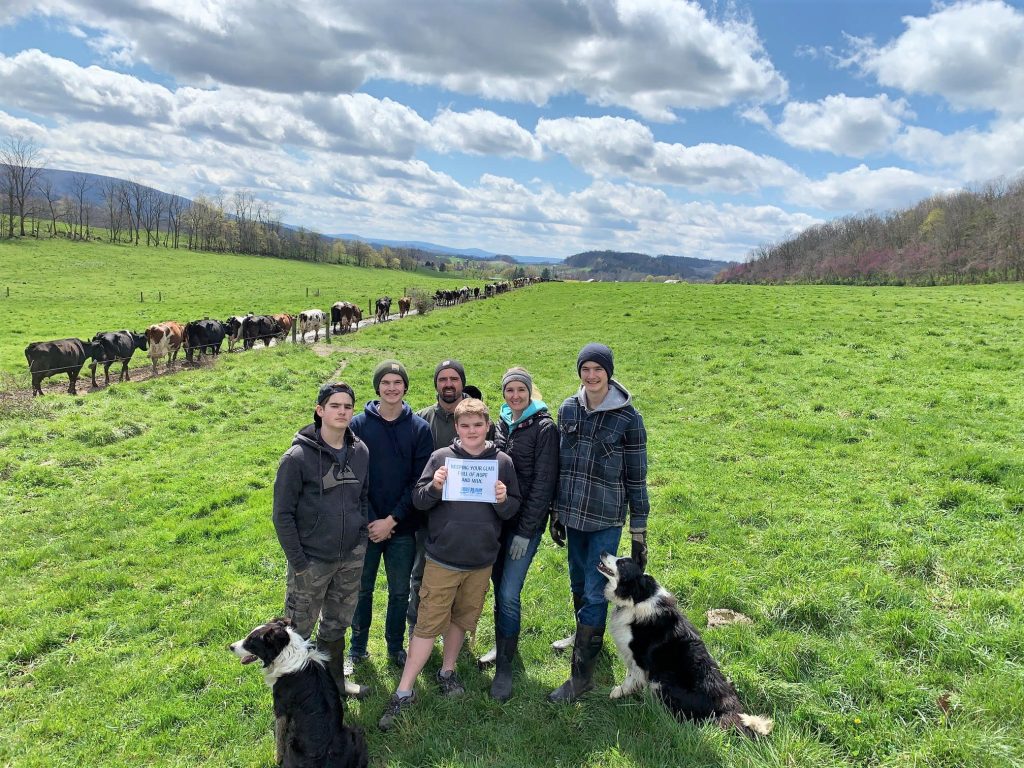
Neil Hertzler Was Interviewed in the “Cow-Side Conversations” Podcast
In the Center for Dairy Excellence’s latest episode of the “Cow-Side Conversations” podcast, Neil Hertzler of Rock Hollow Dairy LLC in Perry County, Pennsylvania shares how his family transitioned their dairy operation to a rotational grazing model years ago. The Hertzlers have 240 milking cows and are passionate about giving their cows as much grass and sunlight as possible. With the start of winter and many grazing herds moving their cows off the grass, Neil describes some of the rewards of a pasture-based model, including strong milk production, herd health and longevity, and lower equipment costs. He also shares some of the challenges, including weather patterns, moving large groups of cattle, heat spells and lameness.
Neil opens the podcast by describing the size and scale of his family’s dairy operation. He farms alongside his wife and four sons as well as his brother-in-law, sister, and a few employees. All together, they farm approximately 600 acres. Half of that acreage is a permanent pasture system. As a seasonal dairy farm, they average about 240 milking cows and go as high as 270 cows. Neil breeds for the spring and fall, so they can match when the grasses are growing strong. His father initiated the rotational grazing model when Neil came home from college in 1999.
“We rotationally graze the cows, and that has been our core. What we love to do is graze cows on grass in a pasture-based system,” Neil says in the podcast. “When I came home from college, I fell in love with that style system. It has been fascinating to me. Before that, our cows were kept in the barn and we brought the feed to them.”
With their initial transition to grazing, Neil says the first steps involved equipment and everything involved with moving cattle out to pasture for their feed. However, he says the most significant change may have been with genetics.
“Our herd had been completely registered Holsteins. After doing research and listening to other grazers, we made the decision to try to breed for some different genetics like New Zealand genetics. We were trying to improve fertility, and we were thinking about seasonality,” Neil explains. “The cheapest way to make milk in a grazing system is with that spring and fall grass. We were trying to match some of that up, so we started breeding cows that were suited for grazing and moving cows to a seasonal calving window.”
Transitioning to a new calving window took time, and their team was patient and slow with the entire process. “I took it really slow. Some people dive right into it, but I gradually moved cows to the spring or the fall and then kind of broke the window up a little bit. Eventually, we were calving two months in the spring and two months in the fall,” Neil adds in the podcast.

They also switched to a swing parlor in 2000 to help with quicker milkings, so cows could be on pasture as much as possible. While their newborn calves do not go onto pasture right away, Neil says they are out on pasture by the time they are a few months old.
Keeping their pastures healthy and getting the most out of their grasses is a key priority at Rock Hollow Dairy. They primarily seed everything to a perennial rye grass, but there are also native grasses and legumes in their pastures. Ultimately, Neil says rest is what keeps the pastures in good condition. By sticking to a strict rotation with their herd, they can prevent the pastures from becoming overgrazed so they have time to regrow. If they take care of the pastures, they also find they do not have to seed as much.
“We try to get a variety of grasses – the more types, the better. But the key thing for pastures is to give them the rest they need. For the milk cows in the spring, we aim for 30 days of rest. They don’t come back around on the rotation for 30 days,” Neil shares. “If we do a good job and don’t have too many cows in the milking string, we can achieve that. In the fall, we have more than just 30 days.”
To continue improving the health of their soil and pastures, the Hertzler family moved their lagoon away from the stream in 2007 and began assessing ways they could reduce the amount of heavy equipment running on their pastures.
“We put in a separation system and irrigation system, so we could irrigate the effluent and compost the solid. Then, we wouldn’t have to run big equipment on the pastures. That has definitely helped, and we have seen a difference from that,” he adds.
Their herd normally starts grazing at the end of March and stays on pasture until about Thanksgiving, depending on weather conditions. Throughout the podcast interview, Neil describes how weather can be an obvious challenge, especially during dry spells like this past year. They find that wetter seasons do not bring as many challenges. As long as their pastures get rest, they still recover well even if there is a lot of mud.
“We always count on that spring moisture, so it was different not having that this past spring. We supplement with haylage if it gets too dry,” Neil explains. “The only other thing we can do is cut back on the herd and bring our numbers down so we can extend our grazing rotation. It can be a challenge, but we’ll still keep rotating the cows even just for the benefit of getting them outside and some sunlight.”
In terms of milk production and components, Neil says they completely stopped feeding grain approximately two years ago. Now, their herd is 100 percent grassfed and certified organic. They heavily rely on pasture and forage quality to achieve their production goals.
“Grass is the cheapest feed. It’s the easiest thing to give them, and it actually makes milk if it’s the right height and quality,” Neil shares.
He says they normally see more than 40 pounds of milk in the peak of spring season, but they take a drop in the summer heat – averaging about 35 pounds throughout the whole year. With the grazing model, their components also range based on the season. Their components often drop during the grazing season, but when cows are fed more forage in the winter months, they see an increase in components. Moving away from grain also helped increase their components. They range from 4.1 to 4.8 percent throughout the year.
Neil closed the podcast by sharing some of the challenges and learning curves they have tackled with their rotational grazing model:
- Moving cattle. “We spend a lot more time moving cows. We save in other areas, but it takes some time to move them. At our farm, the milking parlor is at the very far Northwest corner. The cows have to walk up to a mile to get to some of the pastures. We’ll take them to farther pastures during the day and closer pastures at night, so it’s not as far to get them for morning milkings. Moving that many animals can really chew up some time during the day.”
- Summer heat. “If it’s just too hot, we’ll try to get the cows out as early as we can in the morning and bring them in sometimes by lunchtime to get them out of the sun. The last few years, we have been planting trees mostly along the lanes and edges for shade and also for hedge rows for them to chew on. It helps their health.”
- Lameness. “The cows have to walk pretty far, so lameness can be an issue. They keep their hooves trimmed down from walking, but we do have some lameness in other ways.”
While they have adjusted their management practices to account for some of these challenges, Neil has seen cost savings with herd health and veterinarian bills.
“The [grazing system] is definitely a lower cost model. I think no matter what model you’re in, though, it’s all about margin and the difference between your income and expenses. All of the things I’ve talked about – healthy cows and having enough replacements – have cut back on costs on our farm,” he shares.
For another dairy producer who is considering switching to a grazing model, Neil says learning from others and determining if you have the ideal set-up are good starting points.
“I think the first thing is, talk to and visit grazing dairies to see what they’re all about. Study it, and try to understand it,” he says. “You also want to consider if your farm is set up for it. An easy thing to do is to start with heifers or youngstock and see how that goes.”
To listen to the full podcast interview with Neil Hertzler, visit www.centerfordairyexcellence.org/podcast. The podcast is also available on Spotify, Apple Podcasts, and Amazon Music. With a new episode released each month, this interview is the first episode in the fourth season. The podcast was designed to share real-time farmer insight, tricks of the trade, and inspiring stories from dairies across Pennsylvania.

